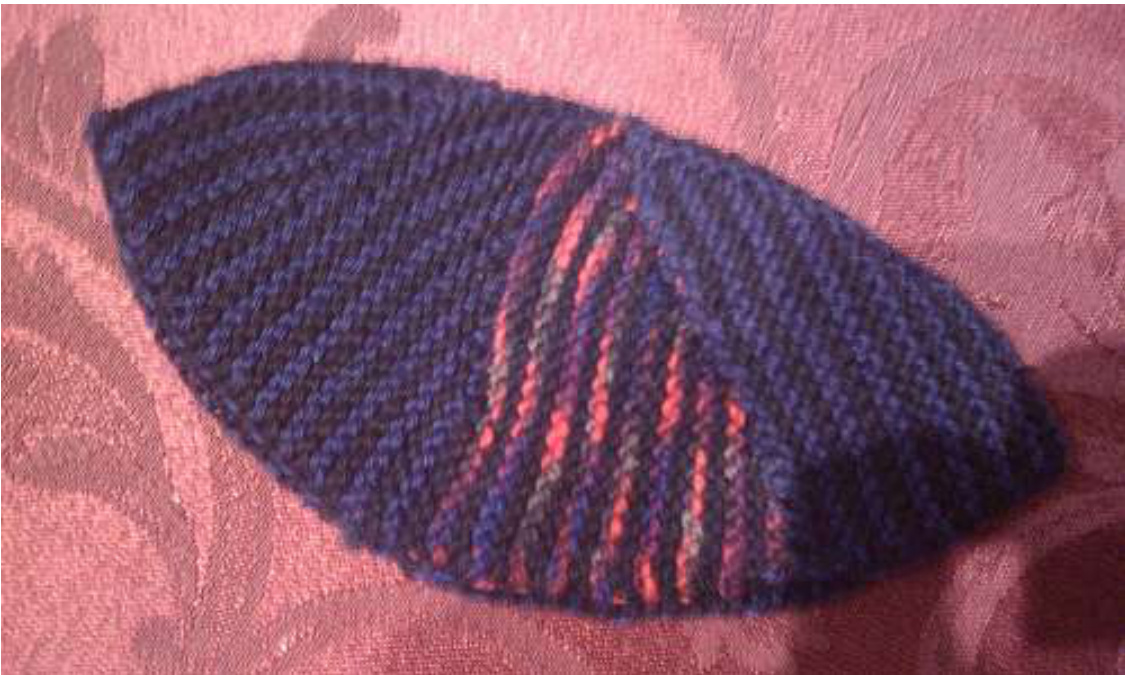The Minyan Kippah (aka The Seven Gates Kippah)

This kippah is so-named because it is a quick-enough knit that I could make enough of these to give as gifts to my entire minyan. Since knitting produces a finer fabric that crochet, the fingering weight yarn is relatively quick to work with yet produces a kippah that isn't too heavy. Please read: While I am distributing this kippah as a free pattern, it is a gift with some strings. Please donate to my Jimmy Fund Marathon Walk - a 26.2-mile walk to raise funds for the Dana-Farber Cancer Institute. I walk every year: in memory of my parents who both died of cancer, and with hope that tomorrow's cancer patients will have an easier future. While the pattern itself might normally be priced at \$3-\$5, I cannot help but observe that \$18 is a Jewishly "round number" and \$180 is even rounder... Naturally all gifts are fully tax-deductible. Just go to http://www.jimmyfundwalk.org/2011/BethK.
Materials:
3 skeins of fingering-weight cotton: 2 colors with minimal contrast (MC1 and MC2) and 1 with high contrast (HC) ·Size 2 needles I made 7 kippot out of the above materials. That works out to about 25 meters each of the two main colors and 5 meters of the contrast color. Gauge: If you use the yarn and needles recommended, I don't think a little variation in gauge will matter. Move up a needle size if your kippah seems too small and move down a needle size if your kippah is too large.
Instructions:
Cast on 24 sts with MC1. Row 1: sl 1 st, k23. Row 2: With MC2, k22, W&T, k to end of row. Row 3: With MC1, k21, W&T, kto end of row. Row 4: With MC2, k20, W&T, k to end of row. Row 5: With MC1, k19, W&T, k to end of row. Row 6: With MC2, k18, W&T, kto end of row. Row 7: With MC1, k17, W&T, kto end of row. Row 8: With MC2, k16, W&T, kto end of row. Row 9: With MC1, k15, W&T, kto end of row. Row 10: With MC2, k14, W&T, k to end of row. Row 11: With MC1, k13, W&T, k to end of row. Row 12: With MC2, k12, W&T, k to end of row. Row 13: With MC1, k11, W&T, kto end of row. Row 14: With MC2, k10, W&T, k to end of row. Row 15: With MC1, k9, W&T, kto end of row. Row 16: With MC2, k8, W&T, kto end of row. Row 17: With MC1, k24, picking up the wrapped stitche they wrapped. Work this row (and the next row) tight. Repeat from Row 1, 5 more times (6 sections completed). Then repeat one more time, replacing MC2 with HC. After row 17, bind off, then use the mattress stitch to sew the kippah together. Weave in ends. Blocking is optional, as is a crocheted edge or any other edge of your choice.
Tips:
1. By alternating colors in each segment it is easy to count rows to keep track of where you are with respect to the short rows. Another trick is that the sts remaining on the LH needle should alternate between MC1 and MC2. For example: if you are knitting with MC1, k all the MC2 sts on the LH needle until only one remains before it alternates with MC1. Wrap that last MC1. 2. When switching colors, always bring the new color in front of the one just used to make a cleaner edge. This will twist the yarn and periodically you can let the kippah dangle and pull the two working yarns to untwist. This is not necessary if you plan to add an edging to the completedkippah.









